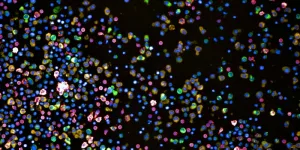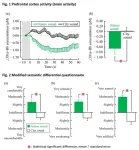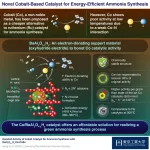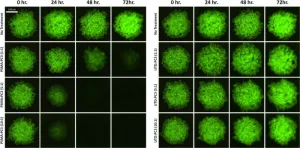(Press-News.org) Multiple myeloma is a rare blood cancer caused by the uncontrolled multiplication of abnormal plasma cells. These plasma cells are a special type of white blood cells that play an important role in the immune system by producing essential antibodies in the bone marrow and lymph nodes.
Despite an increasing number of approved drugs and treatment approaches such as immunotherapy becoming available, the disease is still not curable. The average life expectancy of patients after diagnosis is only five years.
One of the main challenges is the cancer’s tendency to return even after treatment. This is because treatment makes the cancer cells more resistant to the drugs used, until eventually, after several rounds of treatment, no effective options remain.
To address this issue, ETH researchers have adapted their screening platform to look for ways out of this problem, and thereby offering new hope for more successful treatment outcomes.
Biopsies under the microscope
The researchers are using a high-throughput screening method called pharmacoscopy, developed by Professor Berend Snijder, to test the effectiveness of various treatments on the patient’s cancer cells.
This state-of-the-art method allows for several hundred different treatment combinations to be tested simultaneously outside the body. By analysing the reactions of the cells to each treatment, they can determine which method holds the most promise for each patient.
To do this, the cells from the biopsies are placed in special plates with 384 small wells, each containing a different combination of potential treatment substances. After 24 hours, the cells are stained using different antibodies, and their reactions are evaluated using images generated by automated microscopy. A deep-learning algorithm is then used to identify and classify the cell types. The process is largely automated, allowing for efficient and accurate analysis of the results.
138 biopsies individually tested
The researchers used pharmacoscopy to closely examine 138 bone marrow biopsies from 89 myeloma patients with different stages of multiple myeloma, including newly diagnosed and untreated, as well as patients that underwent multiple treatment rounds.
The goal was to observe the behaviour of cancer cells in response to various approved drugs and drug combinations in each biopsy. Based on the cells’ appearance, the researchers could determine the best treatment option for each patient.
Although the Snijder lab had previously used pharmacoscopy in similar studies on other types of blood cancer, such as lymphomas and leukaemias, the platform had to be adapted for this myeloma study.
Hope for more effective treatments
The groundbreaking work done by the researchers at ETH and University Hospital Zurich offers hope for more effective treatments for multiple myeloma. By using Pharmacoscopy to test hundreds of treatments, the researchers were able to identify new, more effective treatment options for each patient.
This new personalized medicine approach is transferable to the clinic and can thus help doctors find the best option for their patients at an early stage. "First, however, we will have to validate the method further in clinical trials," says Snijder.
Now, the Snijder lab wants to develop the platform further to expand its use to solid tumours. Unlike blood cancers, solid tumours must first be dissociated to a certain degree before they can be tested in the 384-well plate format. They are currently adapting the screening platform for brain tumours, among others.
END
How can we fight blood cancer more effectively?
2023-04-27
ELSE PRESS RELEASES FROM THIS DATE:
Researchers call for national governments to mandate real-time indoor air quality monitoring
2023-04-27
In a response to the COVID-19 pandemic, a team of researchers has published an editorial calling for national governments to consider mandating real-time indoor air quality monitoring in at least all public buildings.
Their editorial is published in the journal Building Simulation on 25 April 2023.
The three-year-long COVID-19 pandemic, caused by the severe acute respiratory syndrome coronavirus 2 (SARS-CoV-2), has revealed that there is a global indoor-air crisis. Vaccination alone has not completely controlled the COVID-19 pandemic and the virus continues to threaten human health and life. Scientists now know most if not nearly all ...
Routine antibiotics don't improve outcomes of post-mastectomy breast reconstruction
2023-04-27
April 27, 2023 – For breast cancer patients undergoing breast reconstruction after mastectomy, avoiding postoperative oral antibiotics does not reduce the risk of infections, reports a study in the May issue of Plastic and Reconstructive Surgery®, the official medical journal of the American Society of Plastic Surgeons (ASPS). The journal is published in the Lippincott portfolio by Wolters Kluwer.
"Our experience suggests that discontinuing routine oral antibiotic treatment after implant-based breast reconstruction ...
MD Anderson and Generate:Biomedicines enter co-development and commercialization agreement to accelerate novel protein therapeutics for oncology using generative AI
2023-04-27
HOUSTON and SOMERVILLE, Mass. ― The University of Texas MD Anderson Cancer Center and Generate:Biomedicines today announced a strategic collaboration to jointly discover and co-develop protein therapeutics for up to five oncology targets in advanced cancers, including small-cell and non-small-cell lung cancer.
Under the co-development and commercialization agreement, MD Anderson and Generate:Biomedicines will each contribute toward creating optimized, potentially best-in-class therapeutics that can rapidly advance into proof-of-concept clinical trials. The agreement combines Generate:Biomedicines’ integrated machine-learning capabilities and experimental/wet lab capabilities – ...
Sounds from nature: A soothing remedy for gambling addiction
2023-04-27
Gambling addiction, also called “pathological gambling” and “gambling disorder (GD),” is known to have severe economic, social, mental, and physical consequences on those affected. One of the major factors contributing to the development and relapse of this disorder is stress. However, studies show that replacing gambling with alternative leisure activities may reduce the likelihood of developing the disorder. In recent years, forest bathing, or “shinrin-yoku,” a form of nature therapy, has emerged ...
Estimating the impact of new high seas activities on the environment: The effects of ocean-surface macroplastic removal on sea surface ecosystems
2023-04-27
“The surface is the skin through which our ocean breathes. It is a critical nursery ground for hundreds, possibly thousands, of species, and it is also one of the most vulnerable regions to human impacts. This is why we must treat the surface with exceptional care. It is an extremely unique and fragile environment, and small impacts at the surface could ripple into large impacts above and below the waves.” - Dr. Rebecca Helm, Assistant Professor of Environmental Science at Georgetown University
New research ...
AI in the ICU
2023-04-27
Clinicians in an intensive care unit need to make complex decisions quickly and precisely, monitoring critically ill or unstable patients around the clock.
Researchers from Carnegie Mellon University's Human-Computer Interaction Institute (HCII) collaborated with physicians and researchers from the University of Pittsburgh and UPMC to determine if artificial intelligence could help in this decision-making process and if clinicians would even trust such assistance.
The team gave 24 ICU physicians access to an AI-based ...
Record ammonia production achieved with inexpensive cobalt catalyst at low temperatures
2023-04-27
Ammonia (NH3) is one of the most widely produced chemicals in the world, with a production of over 187 million tons in 2020. About 85% of it is used to produce nitrogenous fertilizers, while the rest is used for refining petroleum, manufacturing a wide range of other chemicals, and creating synthetic fibers such as nylon. However, all this comes at a high energy cost. Currently, most of the ammonia is produced using the conventional Haber-Bosch process, which requires combining nitrogen and hydrogen at high temperatures (400-450°C) and pressures (200 atmospheres). As a result, scientists ...
Analyzing CAR-T cells with image cytometry for potential solid tumor treatments
2023-04-27
Oak Brook, IL – The April 2023 issue of SLAS Discovery contains six full-length articles and one mini-review covering high-throughput screening (HTS) for protease-inhibiting drugs, high-content phenotypic screening and other life sciences research.
Featured in this month’s issue is the article “High-Throughput Method to Analyze the Cytotoxicity of CAR-T Cells in a 3D Tumor Spheroid Model Using Image Cytometry,” by Zurowski, et al, where the authors focus on the use of chimeric ...
10 popular diets scored for heart-healthy elements; some need improvement
2023-04-27
Statement Highlights:
A new American Heart Association scientific statement assesses and scores the heart healthiness of popular dietary patterns.
Several dietary patterns, including the DASH-style eating plan, Mediterranean, pescatarian and vegetarian eating patterns, received top ratings for aligning with the Association’s dietary guidance.
A few eating patterns, including Paleo and ketogenic diets, contradict the Association’s guidance and did not rank as heart-healthy eating patterns.
The statement suggests opportunities for dietary research and interventions to promote health equity, recognizing the importance of social determinants of health in shaping dietary ...
Twilight zone at risk from climate change
2023-04-27
Life in the ocean’s “twilight zone” could decline dramatically due to climate change, new research suggests.
The twilight zone (200m to 1,000m deep) gets very little light but is home to a wide variety of organisms and billions of tonnes of organic matter.
The new study warns that climate change could cause a 20-40% reduction in twilight zone life by the end of the century.
And in a high-emissions future, life in the twilight zone could be severely depleted within 150 years, with no recovery for ...






